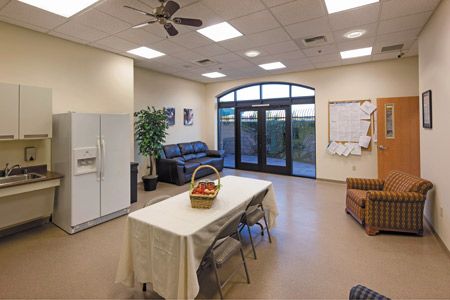The around-the-clock advantage in veterinary practice
24/7 hours can set you apart from competitors, but consider first whether it'll work for your practice.
Next >
Each year, the veterinary community sees an increasing number of 24/7 emergency clinics popping up across the country-some are brand new, while others are renovated practices making the switch to offering around-the-clock veterinary care. Veterinarians and architects are wondering about the emerging trend.
“Pet owners want instant access to animal care after hours in much the same way that parents want it for their kids,” says Sal Longo, AIA, an architect who works on veterinary hospitals. “Also, there is some peace of mind in being able to bring your pet to your regular hospital after hours, since all of their records are there.”
Whether you're building new or remodeling your existing practice to accommodate 24-hour services, your main design considerations should be efficiency and safety, says Longo.
“At night you may have fewer employees; they need to be able to run the facility on their own and feel safe doing so,” he says.
Longo suggests installing a buzzer system for the front door of your hospital to prevent just anyone from walking through the door as well as having a small vestibule where clients can wait to be buzzed in.
Dr. Fred Metzger, practitioner and owner of Metzger Animal Hospital in State College, Pa., went 24/7 in January and says it was a logical move he's glad he made.
“We've always covered our own emergencies via an on-call doctor. The cases we see can be very complicated, so 24-hour care was a natural next step for us,” says Metzger.
But how do you know if it's a good decision for your clinic? Metzger says for him, the largest adjustment was staffing, which is a significant investment.

Mueller's emergency entrance allows night clients to contact the employees vocally and visually from inside the glass vestibule. A staff member can communicate with the client and allow entry through the inner door with the press of a button.
Ed Asmus, Ed Asmus Photography
The most important advice Dr. Metzger would give to practice owners looking into going 24/7 is this: “Figure out your payroll costs first, because operating an emergency practice is a risky venture. You will need three full-time doctors at a minimum plus technical staff, so get your wallet out!”
However, the response he has received from clients and referring doctors makes it all seem worth it for his practice thus far.
“Some of them were going to a competing veterinary emergency practice that was just overnight, not 24/7. This meant clients needed to pick up their pets and transfer them in the morning, which is inconvenient-and in my opinion, dangerous,” says Metzger.
But the most important benefit of all? “Simply better patient care!” he says. “Patient treatments can be adjusted in real time by the emergency doctor, and client communication is greatly improved.”

Longo recommends a larger break room because the night staff probably won't be able to leave to get food, and employees can rest there during slow times.The staff lounge at the 2014 Hospital of the Year Mueller Pet Medical Center has quick access to the treatment area, a full kitchen, comfy seating and even a private patio.
Ed Asmus, Ed Asmus Photography